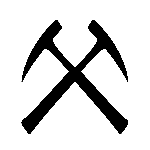Chapter 10: Water
- Page ID
- 40966
\( \newcommand{\vecs}[1]{\overset { \scriptstyle \rightharpoonup} {\mathbf{#1}} } \)
\( \newcommand{\vecd}[1]{\overset{-\!-\!\rightharpoonup}{\vphantom{a}\smash {#1}}} \)
\( \newcommand{\dsum}{\displaystyle\sum\limits} \)
\( \newcommand{\dint}{\displaystyle\int\limits} \)
\( \newcommand{\dlim}{\displaystyle\lim\limits} \)
\( \newcommand{\id}{\mathrm{id}}\) \( \newcommand{\Span}{\mathrm{span}}\)
( \newcommand{\kernel}{\mathrm{null}\,}\) \( \newcommand{\range}{\mathrm{range}\,}\)
\( \newcommand{\RealPart}{\mathrm{Re}}\) \( \newcommand{\ImaginaryPart}{\mathrm{Im}}\)
\( \newcommand{\Argument}{\mathrm{Arg}}\) \( \newcommand{\norm}[1]{\| #1 \|}\)
\( \newcommand{\inner}[2]{\langle #1, #2 \rangle}\)
\( \newcommand{\Span}{\mathrm{span}}\)
\( \newcommand{\id}{\mathrm{id}}\)
\( \newcommand{\Span}{\mathrm{span}}\)
\( \newcommand{\kernel}{\mathrm{null}\,}\)
\( \newcommand{\range}{\mathrm{range}\,}\)
\( \newcommand{\RealPart}{\mathrm{Re}}\)
\( \newcommand{\ImaginaryPart}{\mathrm{Im}}\)
\( \newcommand{\Argument}{\mathrm{Arg}}\)
\( \newcommand{\norm}[1]{\| #1 \|}\)
\( \newcommand{\inner}[2]{\langle #1, #2 \rangle}\)
\( \newcommand{\Span}{\mathrm{span}}\) \( \newcommand{\AA}{\unicode[.8,0]{x212B}}\)
\( \newcommand{\vectorA}[1]{\vec{#1}} % arrow\)
\( \newcommand{\vectorAt}[1]{\vec{\text{#1}}} % arrow\)
\( \newcommand{\vectorB}[1]{\overset { \scriptstyle \rightharpoonup} {\mathbf{#1}} } \)
\( \newcommand{\vectorC}[1]{\textbf{#1}} \)
\( \newcommand{\vectorD}[1]{\overrightarrow{#1}} \)
\( \newcommand{\vectorDt}[1]{\overrightarrow{\text{#1}}} \)
\( \newcommand{\vectE}[1]{\overset{-\!-\!\rightharpoonup}{\vphantom{a}\smash{\mathbf {#1}}}} \)
\( \newcommand{\vecs}[1]{\overset { \scriptstyle \rightharpoonup} {\mathbf{#1}} } \)
\( \newcommand{\vecd}[1]{\overset{-\!-\!\rightharpoonup}{\vphantom{a}\smash {#1}}} \)
\(\newcommand{\avec}{\mathbf a}\) \(\newcommand{\bvec}{\mathbf b}\) \(\newcommand{\cvec}{\mathbf c}\) \(\newcommand{\dvec}{\mathbf d}\) \(\newcommand{\dtil}{\widetilde{\mathbf d}}\) \(\newcommand{\evec}{\mathbf e}\) \(\newcommand{\fvec}{\mathbf f}\) \(\newcommand{\nvec}{\mathbf n}\) \(\newcommand{\pvec}{\mathbf p}\) \(\newcommand{\qvec}{\mathbf q}\) \(\newcommand{\svec}{\mathbf s}\) \(\newcommand{\tvec}{\mathbf t}\) \(\newcommand{\uvec}{\mathbf u}\) \(\newcommand{\vvec}{\mathbf v}\) \(\newcommand{\wvec}{\mathbf w}\) \(\newcommand{\xvec}{\mathbf x}\) \(\newcommand{\yvec}{\mathbf y}\) \(\newcommand{\zvec}{\mathbf z}\) \(\newcommand{\rvec}{\mathbf r}\) \(\newcommand{\mvec}{\mathbf m}\) \(\newcommand{\zerovec}{\mathbf 0}\) \(\newcommand{\onevec}{\mathbf 1}\) \(\newcommand{\real}{\mathbb R}\) \(\newcommand{\twovec}[2]{\left[\begin{array}{r}#1 \\ #2 \end{array}\right]}\) \(\newcommand{\ctwovec}[2]{\left[\begin{array}{c}#1 \\ #2 \end{array}\right]}\) \(\newcommand{\threevec}[3]{\left[\begin{array}{r}#1 \\ #2 \\ #3 \end{array}\right]}\) \(\newcommand{\cthreevec}[3]{\left[\begin{array}{c}#1 \\ #2 \\ #3 \end{array}\right]}\) \(\newcommand{\fourvec}[4]{\left[\begin{array}{r}#1 \\ #2 \\ #3 \\ #4 \end{array}\right]}\) \(\newcommand{\cfourvec}[4]{\left[\begin{array}{c}#1 \\ #2 \\ #3 \\ #4 \end{array}\right]}\) \(\newcommand{\fivevec}[5]{\left[\begin{array}{r}#1 \\ #2 \\ #3 \\ #4 \\ #5 \\ \end{array}\right]}\) \(\newcommand{\cfivevec}[5]{\left[\begin{array}{c}#1 \\ #2 \\ #3 \\ #4 \\ #5 \\ \end{array}\right]}\) \(\newcommand{\mattwo}[4]{\left[\begin{array}{rr}#1 \amp #2 \\ #3 \amp #4 \\ \end{array}\right]}\) \(\newcommand{\laspan}[1]{\text{Span}\{#1\}}\) \(\newcommand{\bcal}{\cal B}\) \(\newcommand{\ccal}{\cal C}\) \(\newcommand{\scal}{\cal S}\) \(\newcommand{\wcal}{\cal W}\) \(\newcommand{\ecal}{\cal E}\) \(\newcommand{\coords}[2]{\left\{#1\right\}_{#2}}\) \(\newcommand{\gray}[1]{\color{gray}{#1}}\) \(\newcommand{\lgray}[1]{\color{lightgray}{#1}}\) \(\newcommand{\rank}{\operatorname{rank}}\) \(\newcommand{\row}{\text{Row}}\) \(\newcommand{\col}{\text{Col}}\) \(\renewcommand{\row}{\text{Row}}\) \(\newcommand{\nul}{\text{Nul}}\) \(\newcommand{\var}{\text{Var}}\) \(\newcommand{\corr}{\text{corr}}\) \(\newcommand{\len}[1]{\left|#1\right|}\) \(\newcommand{\bbar}{\overline{\bvec}}\) \(\newcommand{\bhat}{\widehat{\bvec}}\) \(\newcommand{\bperp}{\bvec^\perp}\) \(\newcommand{\xhat}{\widehat{\xvec}}\) \(\newcommand{\vhat}{\widehat{\vvec}}\) \(\newcommand{\uhat}{\widehat{\uvec}}\) \(\newcommand{\what}{\widehat{\wvec}}\) \(\newcommand{\Sighat}{\widehat{\Sigma}}\) \(\newcommand{\lt}{<}\) \(\newcommand{\gt}{>}\) \(\newcommand{\amp}{&}\) \(\definecolor{fillinmathshade}{gray}{0.9}\)- Components and definition of the hydrologic cycle
- Water users and volume of water used
- How water is shared among people
- Distribution of water on the planet
- Define aquifer and confining layer
- Properties required for a good aquifer
All life requires water. The hydrosphere (Earth’s water) is an important agent of geologic change. It shapes our planet through weathering and erosion, deposits minerals that aid in lithification, and alters rocks after they are lithified. Water carried by subducted oceanic plates causes melting in the upper mantle material. Communities rely on suitable water sources for consumption, power generation, crop production, and many other things.
- Section 10.1: Prelude to Water
- n pre-industrial civilizations, control of water resources was a symbol of power. Two thousand-year-old Roman aqueducts still grace European, Middle Eastern, and North African skylines. Ancient Mayan kings used water imagery such as frogs, water-lilies, waterfowl to show their divine power over their societies' water resources. Control over water continues to be an integral part of the governmental duties of most modern societies.
- Section 10.2: Properties of Water
- The physical and chemical properties of water are what make it essential to life and useful to civilization. Water is a molecule made of one negatively charged (-2) oxygen ion and two positively-charged (+1) hydrogen ions, giving it the chemical formula H2O, with strong covalent bonds between the oxygen and two hydrogen ions. The shape of the water molecule allows for an uneven distribution of charge, where one side is slightly positive and one side is slightly negative.
- Section 10.3: Surface Water
- A stream or river is a body of flowing surface water confined to a channel. Terms such as creeks and brooks are social terms not used in geology. Streams are the most important agents of erosion and transportation of sediments on the earth’s surface. They create much of the surface topography and are an important water resource. Most of this section will focus on stream location, processes, landforms, and hazards. Water resources and groundwater processes will be discussed in later sections.
- Section 10.4: Groundwater
- Most rocks are not entirely solid and contain a certain amount of open space between grains or crystals, known as pores. Porosity is a measure of the open space in rocks –expressed as the percentage of open space that makes up the total volume of the rock or sediment material. Porosity can occur as primary porosity, which represents the original pore spaces in the rock (e.g. space between sand grains), or secondary porosity which occurs after the rock forms (e.g. dissolved portions of rock).
- Section 10.5: Glaciers
- The hydrosphere, liquid water, is the single most important agent of erosion and deposition. The cryosphere, the solid state of water in the form of ice also has its own unique erosional and depositional features. Large accumulations of year-round ice on the land surface are called glaciers. Masses of ice floating on the ocean as sea ice or icebergs are not glaciers, although they may have had their origin in glaciers.
- Section 10.6: Waves and Wave Processes
- Waves are created when wind blows over the surface of the water. Energy is transferred from wind to the water by friction and carried in the upper part of the water by waves. Waves move across the water surface with individual particles of water moving in circles, the water moving forward with the crest and moving backward in the trough. This can be demonstrated by watching the movement of a cork or some floating object as a wave passes.
- Section 10.7: Shoreline Features
- Many different erosional and depositional features exist in the high energy of the coast. The coast or coastline includes all parts of the land-sea boundary area that are directly affected by the sea. This includes land far above high tide and well below normal wave base. But the shore or shoreline itself is the direct interface between water and land that migrates with the tides and with deposition and erosion of sediment. Processes at the shoreline are called littoral processes.
Thumbnail: Violent water below Niagara Falls. (CC-BY; The Rafti Institute).


